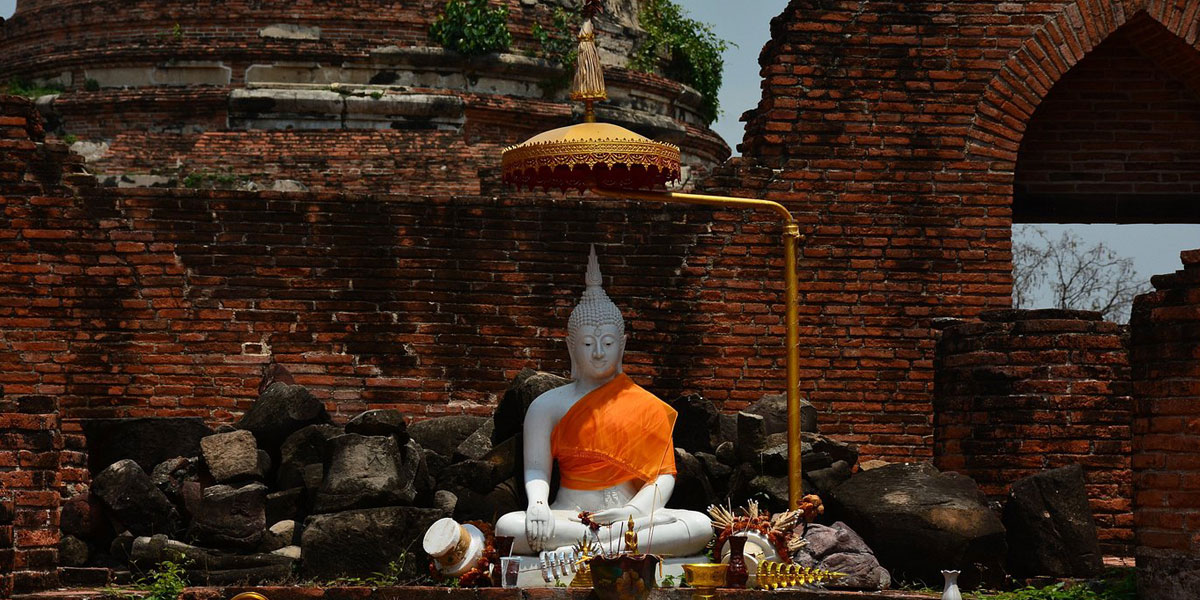Wat Kudi Dao is a quiet, partly restored monastery ruin where brick, stucco, and sunlight create a calm mood that many visitors find deeply peaceful. The temple sits within the historic core of Ayutthaya, yet it feels set apart because large open courtyards and low surrounding walls let the breeze move through the site. You will see an ordination hall, a main assembly hall, traces of a central shrine, and several elegant chedis that anchor the grounds. Paths are simple and flat, and the ruins are easy to read even for first time visitors. Wat Kudi Dao rewards slow walking, careful looking, and respectful silence.
Historical Overview
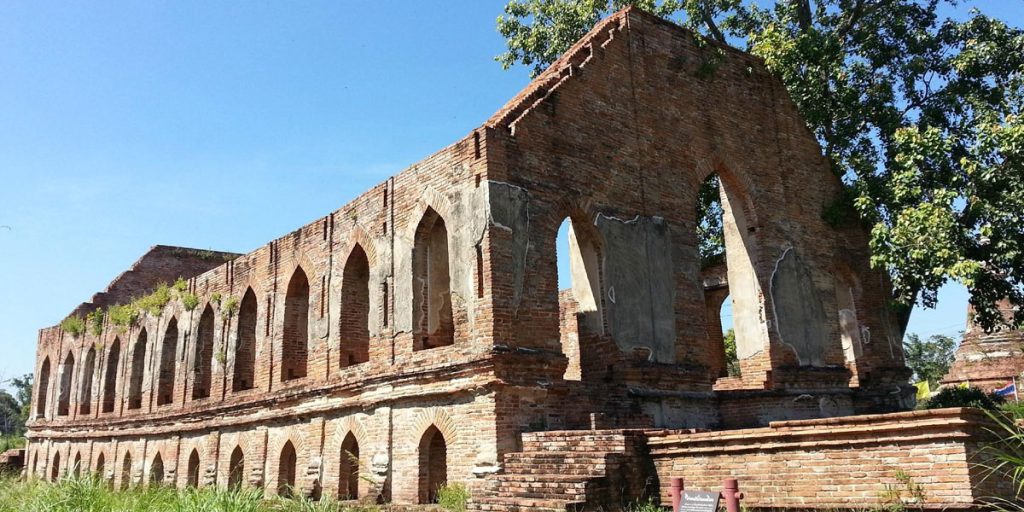
This site tells a late chapter of Ayutthaya’s monastic story, and Wat Kudi Dao lets you imagine how a royal era temple complex once functioned day to day with monks, worshippers, and visiting patrons.
- Founding Context: Scholars generally place the foundation in the later Ayutthaya period, when large monasteries combined spiritual roles with learning, hospitality, and limited community services such as teaching and copying texts.
- Royal Patronage: Surviving elements suggest support from elite patrons who funded large halls, boundary stones, and multiple reliquary chedis that would have housed sacred objects and relics.
- Monastic Life: The compound likely hosted a resident monk community with spaces for chanting, study of Pali scriptures, and meditation in shaded galleries and open cloisters.
- Periodic Restorations: Brickwork patterns and stucco traces indicate the complex went through phases of repair and embellishment as tastes and resources changed across generations.
- Decline And Quiet: After the fall of the old capital, structures eroded and timber disappeared, leaving the durable brick cores that define the site today.
Architectural Layout
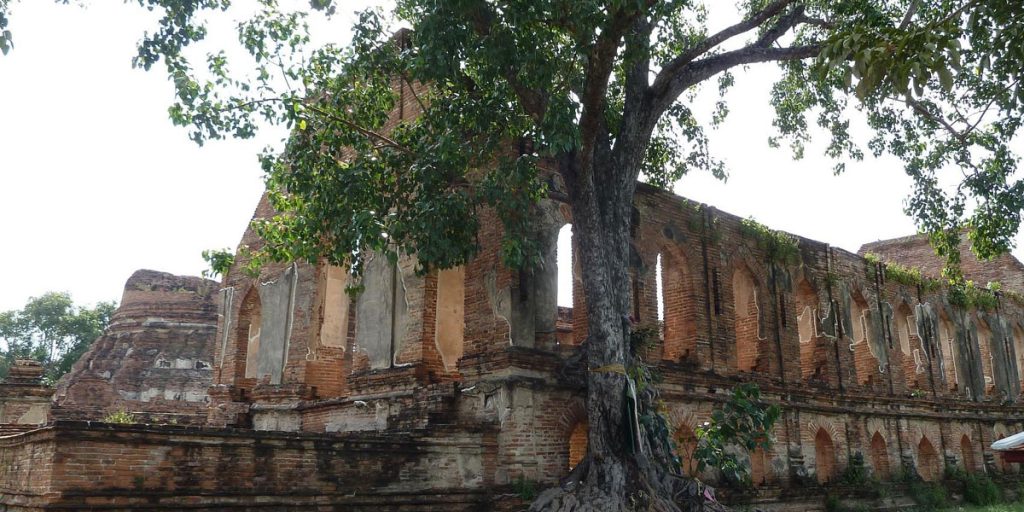
The overall plan is legible even as a ruin, and Wat Kudi Dao is arranged along a simple axis that leads you from an outer approach to the most sacred inner structures with clarity and balance.
- Orientation And Axis: A straight walkway guides you from a simple entrance toward the principal buildings, creating a ceremonial progression that mirrors the journey from secular space to sacred heart.
- Ubosot Placement: The ordination hall sits within marked boundaries defined by sema stones, signifying a legally sacred zone for monastic rituals such as novice ordinations and recitations.
- Viharn Scale: The large assembly hall accommodated lay devotees and monks for daily chants, sermons, and special festival gatherings, while side aisles eased movement during crowded ceremonies.
- Principal Shrine: The central sacred focus, once capped by a tower or large chedi, anchored the sightlines and provided a physical expression of ascent and liberation.
- Peripheral Chedis: Smaller chedis at corners and along the perimeter offered additional reliquary points and visual balance, drawing the eye back to the main axis.
- Enclosure And Walkways: Low walls and remnants of cloister walks created quiet corridors for circumambulation, devotion, and reflection without interrupting breezes.
- Materials: Laterite foundations support fired brick masses with stucco finishing, a classic combination that allowed builders to create crisp moldings and lotus base profiles.
Artistic Details And Symbolism
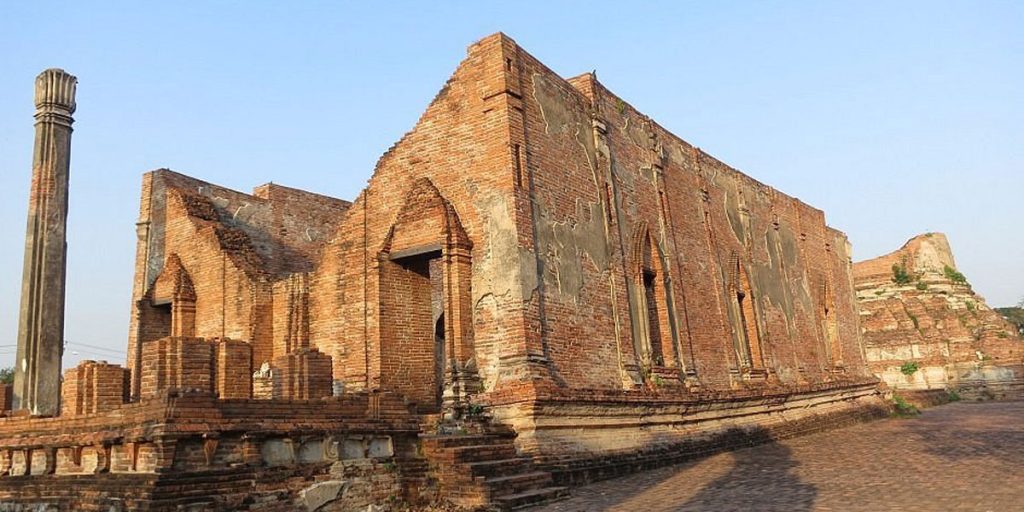
Fragments of stucco and carved moldings still speak clearly, and Wat Kudi Dao rewards patient viewing of motifs that encode merit, protection, and the path toward release from suffering.
- Lotus Motifs: Lotus bases and petal bands symbolize purity emerging from the mud of ordinary life, a visual meditation repeated around plinths and niches.
- Naga And Guardians: Serpentine forms and guardian figures once framed stairways and thresholds, signaling protection for sacred interiors and the teachings held within.
- Pediment Layers: Gable fragments and cornice lines reveal stacked rhythms that helped roofs appear to float, reducing visual weight and lifting attention skyward.
- Stucco Traces: Smooth lime plaster once unified brick cores and allowed fine details, including bead strings, flame tips, and vegetal curls around niches.
- Relic Meaning: Reliquary chedis remind visitors that the Dharma lives through preserved memory and practice, not only through architectural grandeur.
Spiritual Atmosphere And Practices
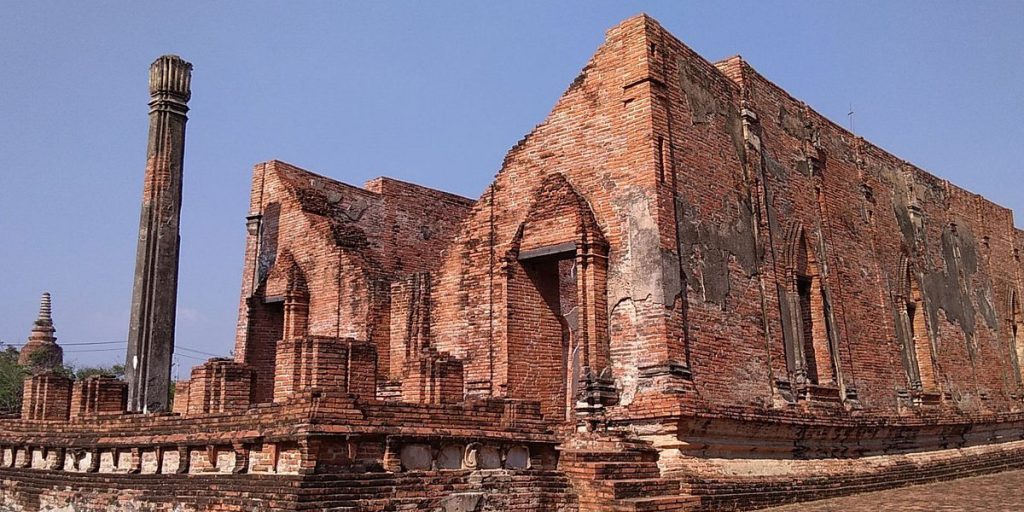
Many travelers come for quiet rather than spectacle, and Wat Kudi Dao remains a place where gentle sounds, open sky, and the cadence of footfalls encourage simple forms of devotion and contemplation.
- Morning Calm: Early light softens brick textures and suits silent walking, seated meditation, or mindful breathing along the main axis and side corridors.
- Chanting Echoes: Even without active services, the geometry of halls hints at the resonance that once amplified collective voices reciting verses and blessings.
- Circumambulation: Walking clockwise around principal structures mirrors traditional practice that aligns body, breath, and attention with the sacred center.
- Offerings: Flowers, incense, and small candles can be placed respectfully at designated spots if present, taking care to leave no residue or litter.
- Reverence First: Modest dress, quiet speech, and unhurried movement keep the site a sanctuary rather than a backdrop for noise.
Planning Your Visit
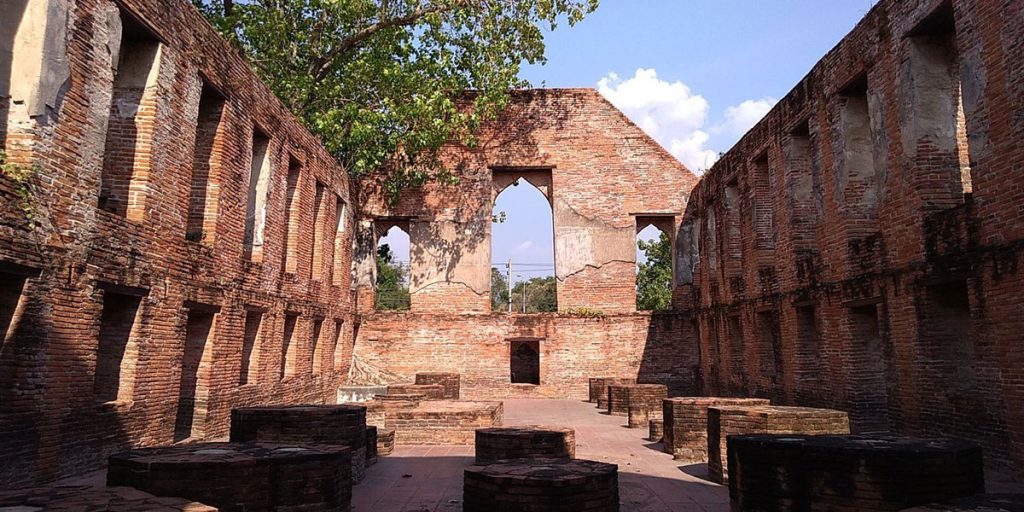
A focused hour is enough for an introduction, yet Wat Kudi Dao offers deeper rewards if you slow down, sketch, photograph with care, or simply sit in shade and let the site unfold.
- Ideal Duration: Plan 45 to 90 minutes to explore the axis, examine details, and revisit your favorite angles at changing light.
- Time Of Day: Early morning and late afternoon provide cooler air and angled sun that sculpts brick textures for photography and sketching.
- Footwear And Surfaces: Flat shoes with good grip suit brick, gravel, and occasional dry grass; avoid climbing on fragile edges or high plinths.
- Sun And Shade: Courtyards can be bright; bring a hat, water, and lightweight clothing to stay comfortable while moving between shaded spots.
- Mindful Pace: Pause at threshold lines, count steps along axes, and compare brick bonds as you move from hall to hall.
Getting There And Orientation
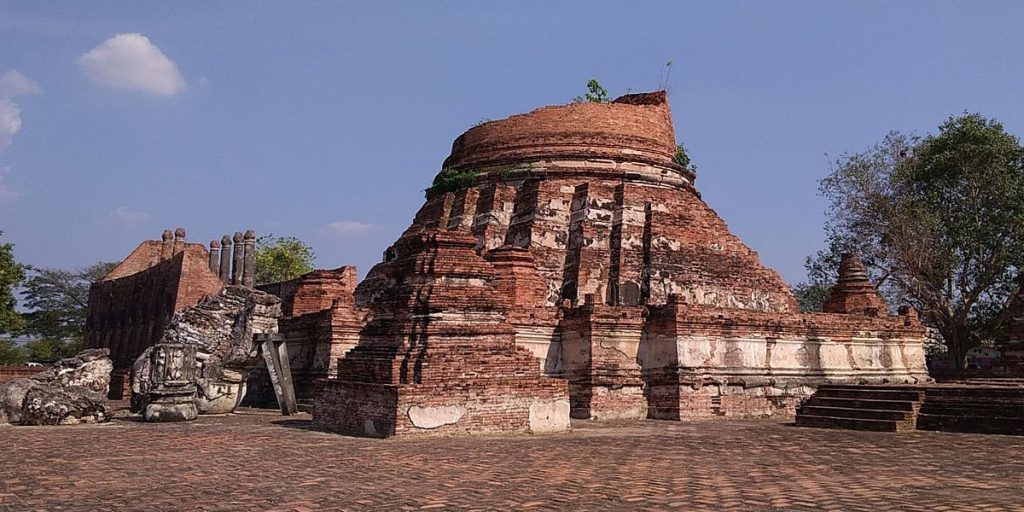
Approach is simple and signage is improving, and Wat Kudi Dao sits in a cluster of monastic ruins where lanes and canals provide context as you orient yourself along the main approach.
- Arrival Points: The primary access road leads to a small parking area or drop off point near the outer wall remains.
- Wayfinding: Follow signs or maps that highlight the axis from entrance to inner core; keep an eye on chedi silhouettes to maintain bearings.
- Quiet Lanes: Peripheral lanes often carry light traffic; remain alert when crossing and use designated paths to reach the gate area.
- Final Approach: The first sightline takes you toward the large hall bases; use this to plan your loop and identify shaded rests.
- Exiting: Leave by retracing the axis or circling the perimeter paths to revisit details you noted earlier.
Entry, Tickets, And Time Needed
Rules are light and respectful, and Wat Kudi Dao is often open during daylight, which lets independent travelers fold a careful visit into a longer day among the old monastery zones.
- Entry Conditions: Many outer ruin compounds are freely accessible during daylight; local notices at the gate take precedence if hours or rules change.
- Passes: When combined with other protected ruins, a park pass may be useful; ask at staffed sites earlier in your day for the latest guidance.
- Time Budgeting: Give yourself enough unstructured time to sit, look carefully, and let small discoveries build into a fuller impression.
- Stewardship: Donate at boxes if present and carry out any trash; small actions help maintenance teams keep the grounds tidy.
- Group Rhythm: If arriving with a group, allow quiet intervals where everyone can pause separately before sharing observations.
Best Hours And Photography Light
Angles of sun make all the difference here, and Wat Kudi Dao comes alive when low light carves ridges of mortar, reveals stucco skins, and throws long shadows across the courtyards.
- Early Light: Shortly after sunrise, front facing walls glow warm while side walls hold cool shade, giving contrast that flat midday light cannot match.
- Golden Evenings: Late afternoon lengthens shadows from chedi bases and sema stones, adding depth and hierarchy to your compositions.
- Cloud Cover: Thin cloud can act like a giant diffuser that softens harshness without erasing relief; wait a few minutes for passing clouds to cooperate.
- Reflected Light: Pale stucco fragments bounce light into recesses; use that to photograph niches and cornice undersides without flash.
- Night Visits: If the compound is unlit, avoid entry after dark to protect your safety and the integrity of the ruins.
Dress Code And Etiquette
Comfort and respect go together, and Wat Kudi Dao is still a sacred space even as a ruin, so modest clothing and considerate behavior help everyone share a calm experience.
- Modest Clothing: Cover shoulders and knees where possible; a light scarf or shawl can help if you arrive in athletic wear.
- Hats And Shoes: Remove hats near altars and step around rather than over threshold stones; never stand on a Buddha base if present.
- Voices And Music: Keep voices soft and avoid speakers; allow the sounds of wind and birds to set the tone.
- Monastic Encounters: If you meet a monk, greet politely with a slight bow and keep a respectful distance unless invited to converse.
- Offerings And Litter: Leave offerings only at designated points and take all packaging with you when you depart.
Accessibility And Comfort
Grounds are mostly level with a few uneven patches, and Wat Kudi Dao can be navigated by most visitors who take care with footing and plan short rests in shade.
- Surface Conditions: Expect compact earth, brick, and some gravel; wheelchairs and strollers may need help over short rough sections.
- Seating Options: Low plinth edges and shaded stones offer brief rest points; bring a cloth if you prefer a cleaner seat.
- Heat Planning: Midday heat can be strong; schedule shade breaks and hydrate often to keep energy steady.
- Restrooms: Facilities may not be present immediately at the compound; plan stops before or after your visit.
- Mobility Considerations: Avoid climbing high bases or narrow ledges; use established steps to move between levels.
Safety, Weather, And Health
Simple preparation keeps the experience easy, and Wat Kudi Dao is safest when you combine good footwear, water, and a realistic plan for the day’s heat and light.
- Footwear Choice: Closed toe shoes with grip protect against loose gravel and hot surfaces while improving balance on uneven brick.
- Sun Strategy: Wear a brimmed hat, apply sunscreen, and favor long sleeves in breathable fabric to reduce sun load.
- Hydration: Carry a refillable bottle and sip regularly; dehydration can sneak up when breezes make heat feel mild.
- Rain Plan: Short tropical showers pass quickly; step under trees or a gallery edge and wait before continuing your circuit.
- Wildlife: Respect ants and lizards; avoid disturbing the ground around nests and do not feed stray animals.
Facilities And Amenities
Services are modest, so arrive self-sufficient, and Wat Kudi Dao will feel more comfortable if you prepare essentials like water, a small first aid kit, and a charged phone.
- Essentials To Carry: Water, hat, sunscreen, small towel, tissues, and a light scarf cover most needs during a one-hour visit.
- Waste Management: Pack in and pack out; use any bins provided and keep the ground free of plastics and wrappers.
- Nearby Services: Shops and cafes cluster near more visited hubs; plan your snack and restroom stops around those times.
- Wayfinding Aids: Bring an offline map or a printed sketch of the plan to mark features as you explore.
- Emergency Numbers: Save local emergency contacts and a taxi number in advance in case of a sudden change in weather or health.
Understanding The Ruins
Reading the site turns a walk into a conversation with the past, and Wat Kudi Dao offers clear clues that help you reconstruct vanished roofs, doors, and interior spaces in your imagination.
- Brick Bonds: Note alternating stretcher and header patterns that strengthened walls and guided plaster adhesion.
- Sema Stones: Boundary markers around the ordination hall define the most sacred area; count them as you circle to sense ritual geometry.
- Plinth Steps: Shallow steps hint at processions and ceremonial approach; worn edges reveal how feet flowed in and out over years.
- Roof Shadows: Look for beam sockets and lintel scars where timber once locked into brick, helping you picture the roof’s weight and pitch.
- Stucco Skin: Remaining plaster patches reveal final surface finishes that once unified color and caught light evenly across façades.
Suggested Walking Route
A simple loop helps first time visitors gain structure, and Wat Kudi Dao works well if you begin at the gate, follow the main axis, circle the inner core, and return along the perimeter.
- Gate To Axis: Start at the entrance and pause to align your sight with the principal hall bases and any surviving chedi crowns.
- Ubosot Circuit: Walk the ordination hall boundary clockwise and notice the sema stones that legally sanctify the space.
- Viharn Focus: Step through the assembly hall and stand where the Buddha image once sat; face outward to feel how the hall organized people.
- Central Shrine: Circle the main sacred base slowly, counting your steps as a mindful practice.
- Perimeter Return: Follow outer paths back to the entrance while scanning for details you missed on the inward walk.
Quiet Spots And Reflection
It is easy to find personal space even on busy days, and Wat Kudi Dao gives you corners where sound drops and the texture of brick invites short, unhurried pauses.
- Northeast Shade: Trees near the side walls create cool air in late morning, a good place for water breaks and note taking.
- West Edge Views: Afternoon sun across the central base creates strong relief that is ideal for sketching profiles and photographing shadows.
- Cloister Corners: Inner corner niches are perfect for brief seated meditation if you remain mindful of other visitors.
- Sound Map: Stand still and listen to birds, leaves, and distant bells, then walk slowly to find the quietest point on the site.
- Gratitude Moment: Before leaving, take a final minute to offer silent thanks and set an intention for the rest of your day.
Culture And Respectful Behavior
Local customs keep sacred places welcoming, and Wat Kudi Dao becomes more meaningful when visitors follow small courtesies that protect both dignity and stone.
- Hands And Feet: Do not point feet toward sacred bases; if you sit, tuck feet back and keep posture modest and calm.
- Touching Surfaces: Avoid rubbing stucco fragments or climbing for photographs; a light visual touch preserves fragile details.
- Shared Space: Step aside for elders, families, and those at prayer, giving them the clearest paths and quietest corners.
- Voices With Purpose: Save long conversations for outside the core and keep any guided talk short and gentle.
- Litter Free Rituals: Remove all offering packaging so sacred spots remain clean for the next visitor.
Seasonal Planning And Climate
Heat and rain shape the mood and comfort of a visit, and Wat Kudi Dao can feel very different across seasons, from bright, breezy days to soft, overcast afternoons that flatter detail.
- Hot Season: Expect strong sun and bright skies; prioritize early and late visits with a long siesta for lunch and rest.
- Rainy Months: Showers can lend dramatic clouds and wet brick that deepens color; use a lightweight umbrella and protect electronics.
- Cool Season: Cooler air and gentle sun make mid mornings more pleasant and extend your comfortable visiting window.
- Wind And Dust: Breezes carry grit that can scratch lenses; use a filter and clean glass with care.
- After Rain: Watch for slick bricks and puddles around base stones; walk slowly and test footing.
Sample Itineraries And Timing
Short or long, your plan will benefit from structure, and Wat Kudi Dao fits neatly into several different day types that balance focus, rest, and creative time on site.
- One Hour Focus: 10 minutes orientation, 20 minutes axis and inner core, 15 minutes details, 15 minutes quiet reflection and photos.
- Two Hour Deep Dive: 20 minutes orientation, 60 minutes close reading of structures, 20 minutes sketching or journaling, 20 minutes photography in shifting light.
- Photo Emphasis: Arrive early, scout compositions without a camera, then capture sequences as light moves from front to side and back.
- Family Plan: Alternate exploration with shade breaks and storytelling about how halls worked, watching energy levels and keeping water handy.
- Creative Circuit: Walk once to see, once to photograph, and a third time to sketch or write, letting new details surface each loop.
Responsible Travel And Preservation
Small choices add up to real stewardship, and Wat Kudi Dao benefits when visitors move gently, leave nothing behind, and share accurate advice without encouraging harmful behavior.
- Stay On Paths: Use established routes to protect fragile edges, tree roots, and soft soils near foundations.
- No Climbing: Avoid climbing bases and chedis; stone and mortar weaken quickly under repeated weight and friction.
- Gentle Voices: Keep sound low to respect others and preserve the contemplative character that sets this place apart.
- Teach By Example: If you travel with friends, model respectful behavior and explain why it matters in living heritage places.
- Gratitude And Support: If donation boxes or local conservation initiatives are present, consider contributing to ongoing care.
What To Notice As You Leave
A final look ties your observations together, and Wat Kudi Dao Ayutthaya feels most complete when you step back, trace the axis in your mind, and remember the way sunlight and shadow organized the space.
- Axis Memory: Picture the straight line from gate to sacred core and how it shaped movement and attention.
- Texture And Tone: Recall the difference between rough brick, smooth stucco, and the soft greens of grass and leaves.
- Human Scale: Imagine the hall filled with voices and the courtyard with visitors, then compare that to today’s quiet.
- Personal Highlights: Note one detail you loved and one question you will research later to deepen your understanding.
- Carry It Forward: Take the calm of the site into the rest of your day, walking slower and noticing more wherever you go.
